Nissan Ariya: Removal and Installation
Inverter (rear) Nissan Ariya 2025
Exploded View
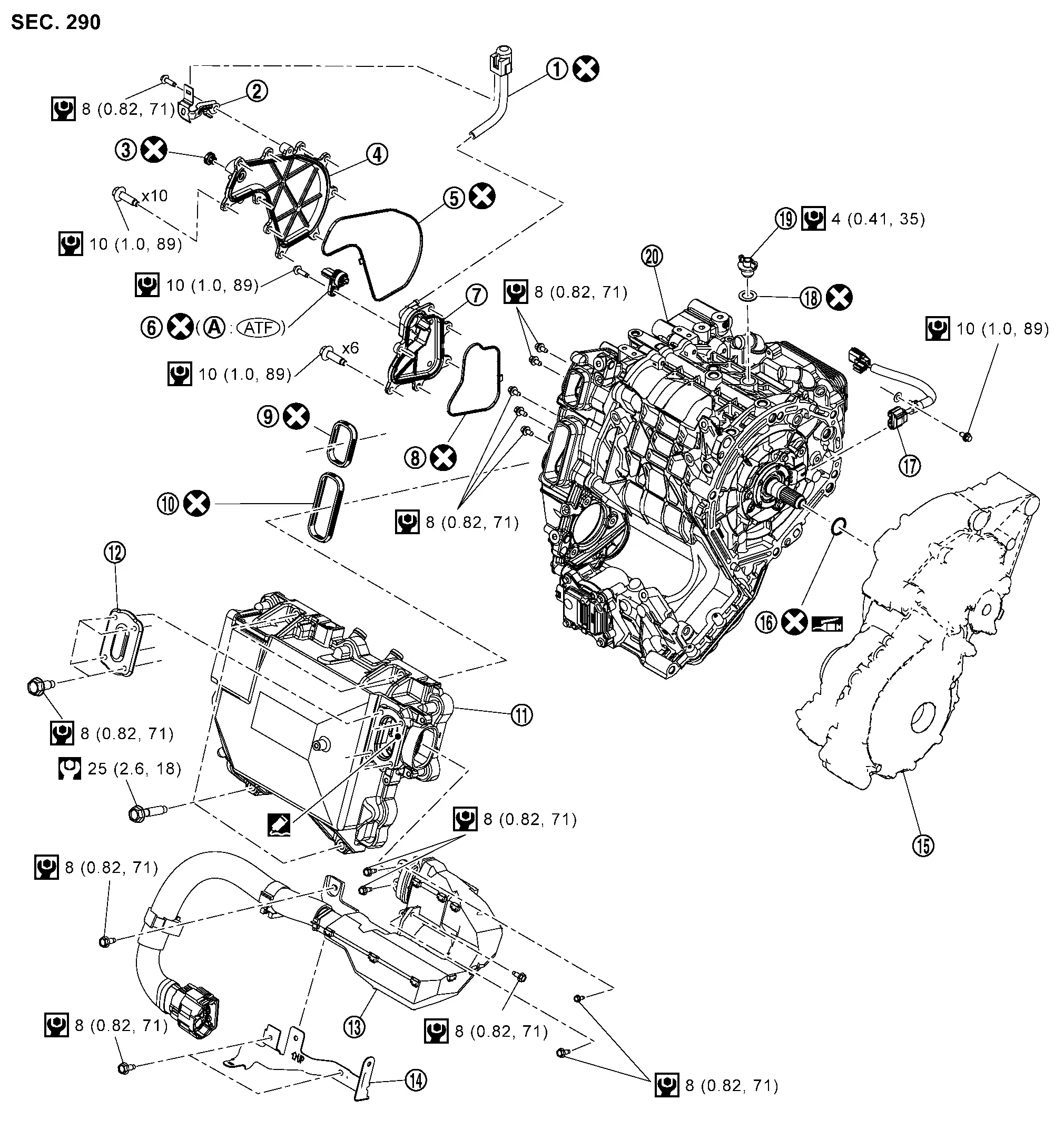
 |
Air breather hose |  |
Bracket |  |
Breather |
 |
Excitation cover |  |
Gasket |  |
Rear traction motor stator temperature sensor joint connector |
 |
3-phase bus bar cover |  |
Gasket |  |
Seal |
 |
Seal |  |
Inverter (rear) |  |
High voltage harness cover |
 |
High voltage harness |  |
Bracket |  |
Rear final drive assembly |
 |
O-ring |  |
Resolver harness |  |
Gasket |
 |
Plug |  |
Rear traction motor assembly | ||
 |
O-ring | ||||
 : N·m (kg-m, in-lb) : N·m (kg-m, in-lb) |
|||||
 : N·m (kg-m, ft-lb) : N·m (kg-m, ft-lb) |
|||||
 : Always replace after every disassembly. : Always replace after every disassembly. |
|||||
 : Apply ATF (Genuine NISSAN Matic S). : Apply ATF (Genuine NISSAN Matic S). |
|||||
 : Apply lithium-based grease including molybdenum disulphide. : Apply lithium-based grease including molybdenum disulphide. |
|||||
 : Apply Genuine Silicone RTV or equivalent. Refer to HOW TO USE THIS MANUAL : Recommended Chemical Products and Sealants. : Apply Genuine Silicone RTV or equivalent. Refer to HOW TO USE THIS MANUAL : Recommended Chemical Products and Sealants. |
|||||
 NOTE:
NOTE:
The tightening torque of the plug  is a reference.
is a reference.
Removal and Installation
DANGER: Since hybrid vehicles and electric vehicles contain a high voltage battery, there is the risk of electric shock, electric leakage, or similar accidents if the high voltage component and Nissan Ariya vehicle are handled incorrectly. Be sure to follow the correct work procedures when performing inspection and maintenance.
Since hybrid vehicles and electric vehicles contain a high voltage battery, there is the risk of electric shock, electric leakage, or similar accidents if the high voltage component and Nissan Ariya vehicle are handled incorrectly. Be sure to follow the correct work procedures when performing inspection and maintenance.
WARNING:
-
Be sure to remove the service plug in order to disconnect the high voltage circuits before performing inspection or maintenance of high voltage system harnesses and parts.
-
The removed service plug must always be carried in a pocket of the responsible worker or placed in the tool box during the procedure to prevent the plug from being connected by mistake.
-
Be sure to wear insulating protective equipment before beginning work on the high voltage system.
-
Never allow workers other than the responsible person to touch the Nissan Ariya vehicle containing high voltage parts. To keep others from touching the high voltage parts, these parts must be covered with an insulating sheet except when using them.
-
Refer to HIGH VOLTAGE PRECAUTIONS : Precautions.
CAUTION:
Never bring the vehicle into the READY status with the service plug removed unless otherwise instructed in the Service Manual. A malfunction may occur if this is not observed.
REMOVAL
WARNING:
Follow the instructions below before starting the procedure.
-
Disconnect high voltage circuit. Refer to HOW TO DISCONNECT HIGH VOLTAGE : Precautions.
-
Check voltage in high voltage circuit. Refer to CHECK VOLTAGE IN HIGH VOLTAGE CIRCUIT : Precautions.
Remove rear suspension member assembly together with rear final drive assembly and rear traction motor with inverter (rear) from Nissan Ariya vehicle. Refer to REAR SUSPENSION MEMBER : Removal & Installation.
Remove rear final drive assembly, rear traction motor and inverter (rear) as a set from rear suspension member assembly, after removing high voltage harness and water hoses. Refer to Removal and Installation.
Remove air breather hose  .
.
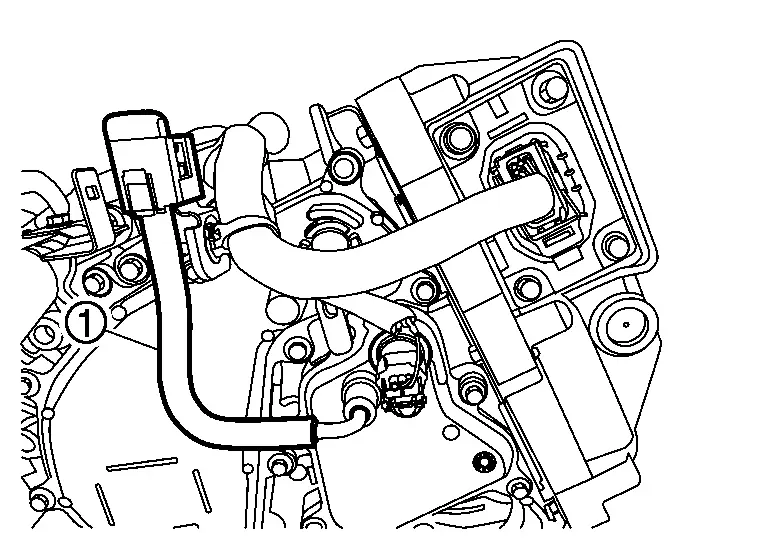
CAUTION:
Never remove air breather hose from tube on 3-phase bus bar cover, when it is not required to replace.
Disconnect harness connector from rear traction motor stator temperature sensor joint connector  .
.
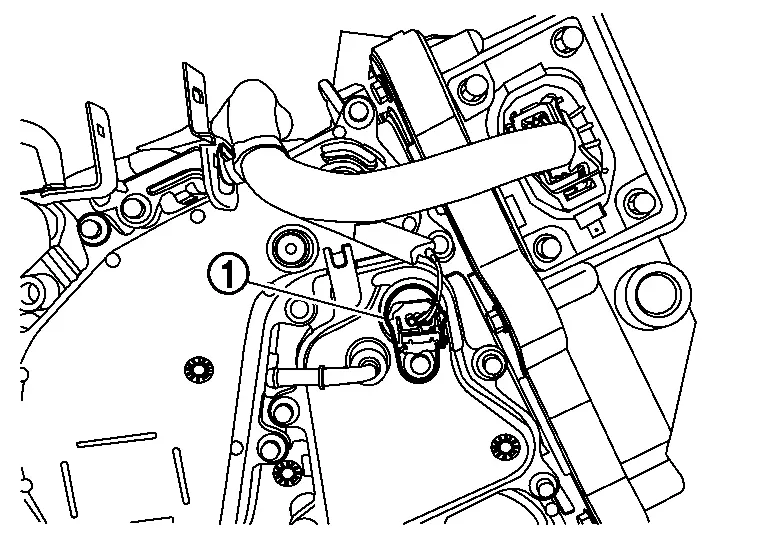
Disconnect harness connector (low voltage connector)  for inverter (rear).
for inverter (rear).
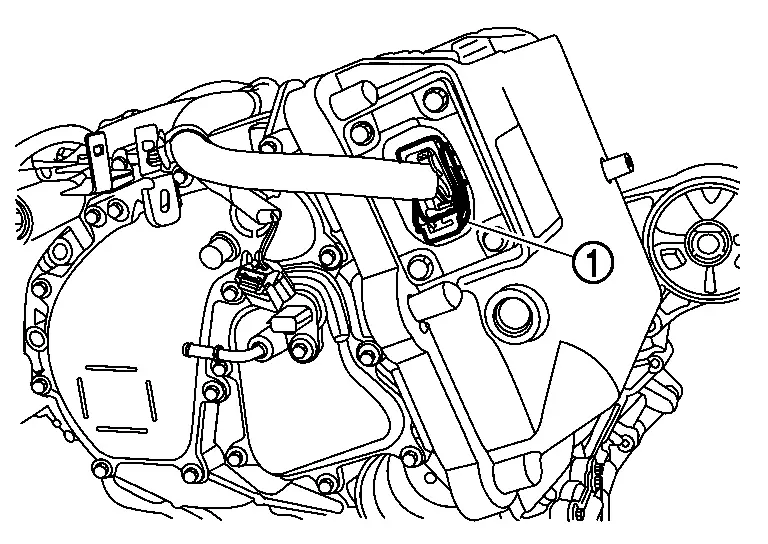
Remove each harness and each bracket.
Remove excitation cover  .
.
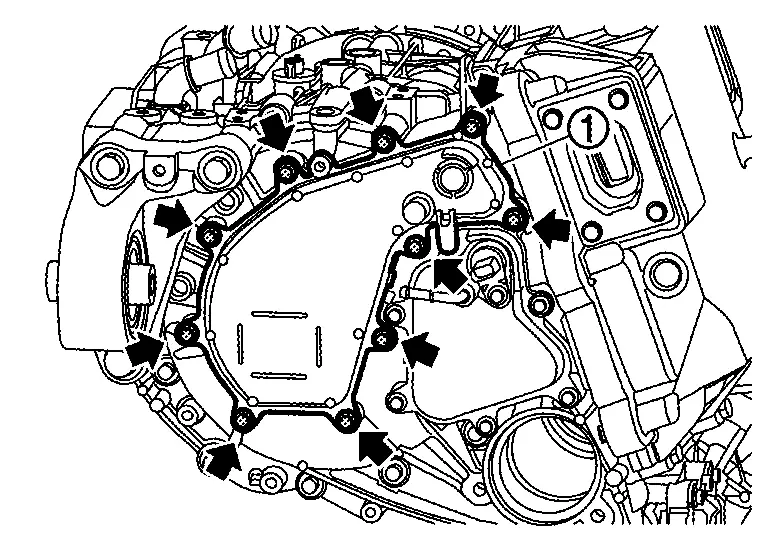
WARNING:
 To prevent electric shock hazards, be sure to put on insulated protective gear.
To prevent electric shock hazards, be sure to put on insulated protective gear.




CAUTION:
-
Never remove breather from excitation cover, when it is not required to replace.
-
Oil may leak out from the opening. If it does, use cloth or other material to wipe it up.
Remove gasket  from excitation cover.
from excitation cover.
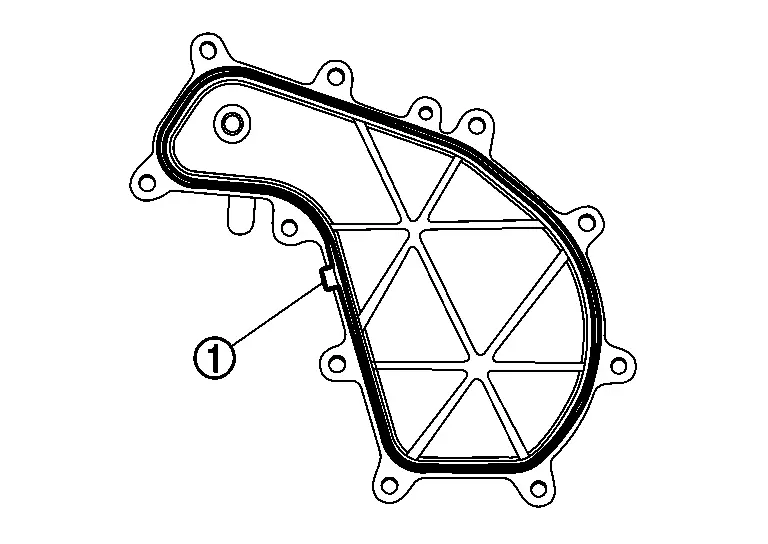
Remove excitation bus bar terminal fixing bolts.
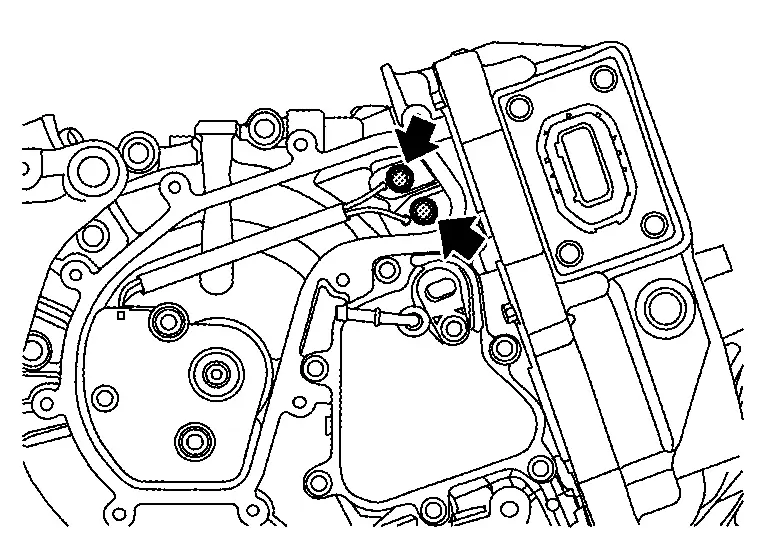
WARNING:
 To prevent electric shock hazards, be sure to put on insulated protective gear.
To prevent electric shock hazards, be sure to put on insulated protective gear.




Remove 3-phase bus bar cover  .
.
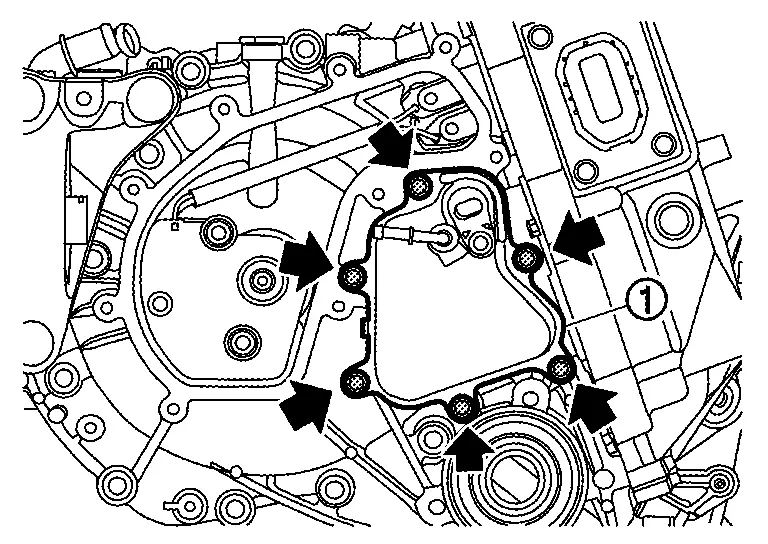
WARNING:
 To prevent electric shock hazards, be sure to put on insulated protective gear.
To prevent electric shock hazards, be sure to put on insulated protective gear.




CAUTION:
-
Never remove rear traction motor stator temperature sensor joint connector from 3-phase bus bar cover, when it is not required to replace.
-
Oil may leak out from the opening. If it does, use cloth or other material to wipe it up.
Disconnect harness connector from rear traction motor stator temperature sensor joint connector.
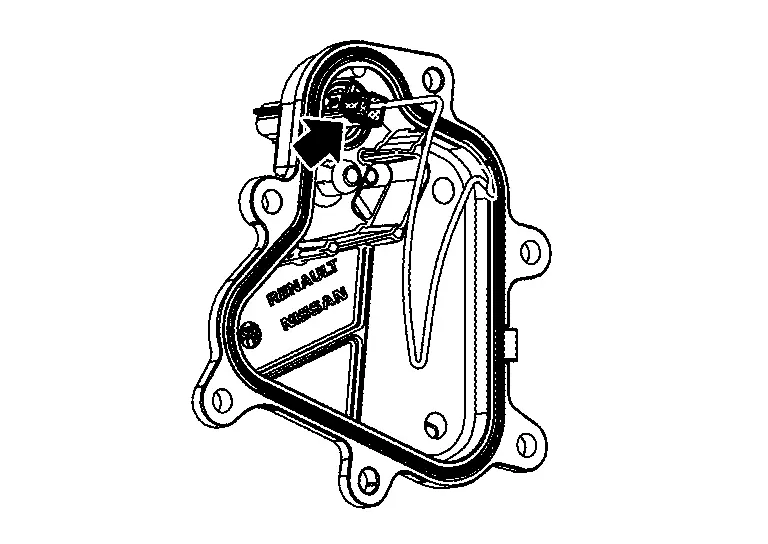
Remove gasket  from 3-phase bus bar cover.
from 3-phase bus bar cover.
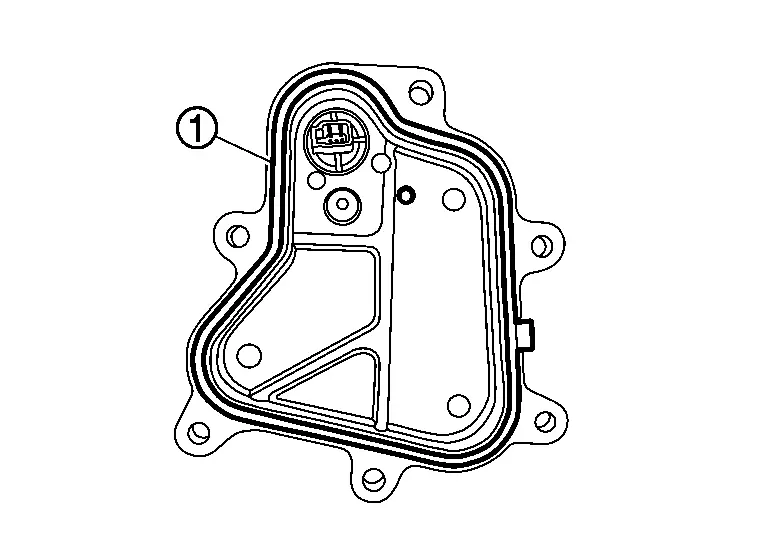
Remove 3-phase bus bar terminal fixing bolts.
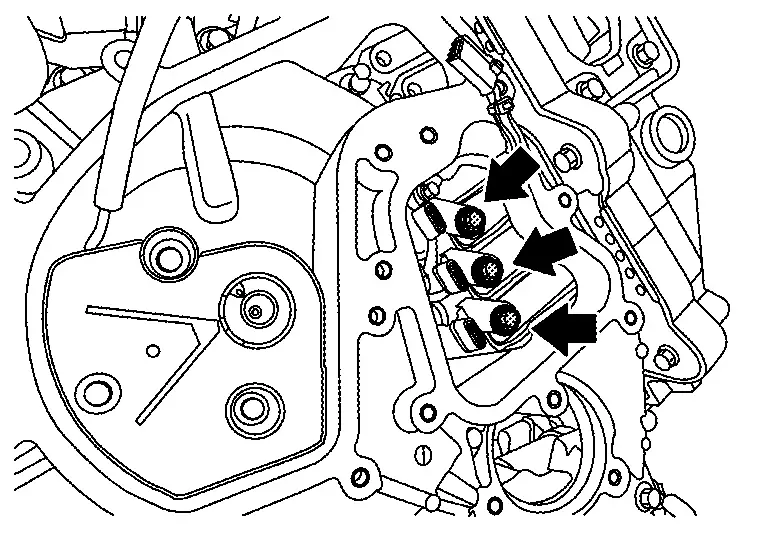
WARNING:
 To prevent electric shock hazards, be sure to put on insulated protective gear.
To prevent electric shock hazards, be sure to put on insulated protective gear.




CAUTION:
-
Never allow the terminal fixing bolt for the 3-phase bus bar terminal to fall into the rear traction motor.
-
After removing the terminal fixing bolts on the 3-phase bus bar terminal, cover all openings of the rear traction motor with tape or other similar material to prevent contamination from dust, dirt, or other foreign materials. When the Nissan Ariya vehicle needs to be left as it is for a prolonged period of time, place the 3-phase bus bar cover in the original position.
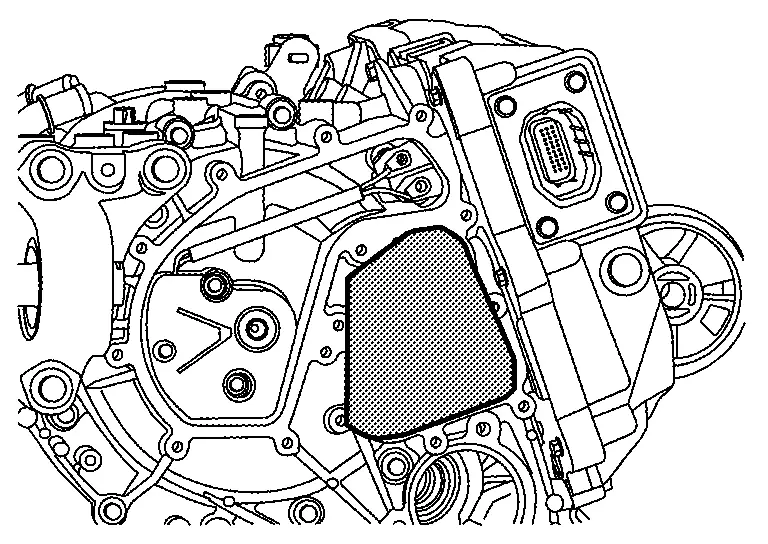
Remove rear motor mounting insulator assembly (front side)  . Refer to Removal and Installation.
. Refer to Removal and Installation.
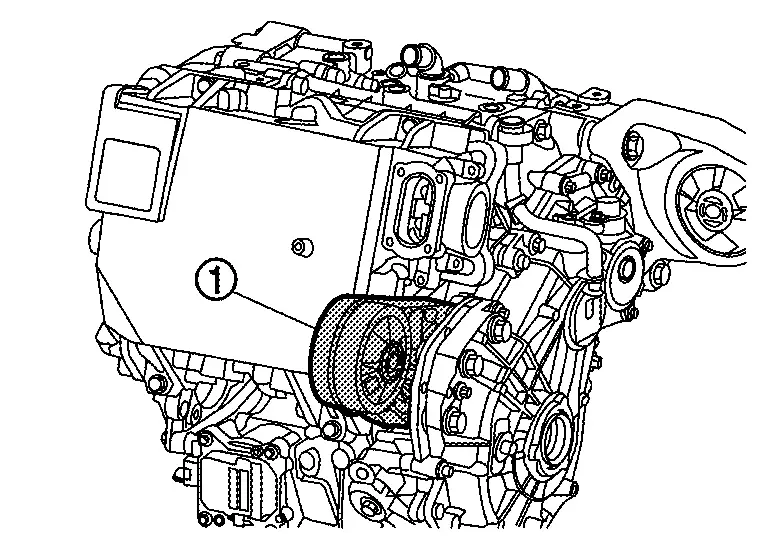
Remove inverter (rear)  after removing mounting bolts.
after removing mounting bolts.
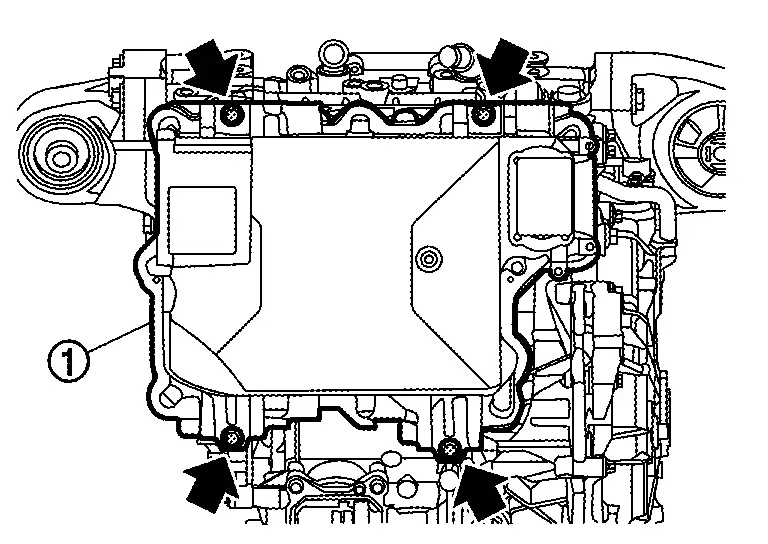
CAUTION:
-
Keep the inverter (rear) in the horizontal position when removing it.
-
Never bend or hit the 3-phase bus bar and the excitation bus bar.
-
When leaving the inverter (rear), cover the 3-phase bus bar and the excitation bus bar with shop cloths
 , and use the wooden blocks to prevent each bus bar interference.
, and use the wooden blocks to prevent each bus bar interference.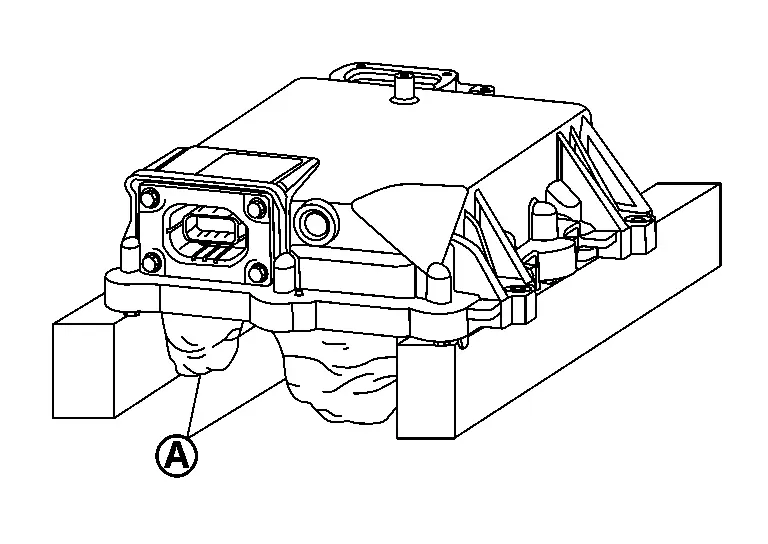
Remove the seal  on the excitation bus bar opening and the seal
on the excitation bus bar opening and the seal  on the 3-phase bus bar opening.
on the 3-phase bus bar opening.
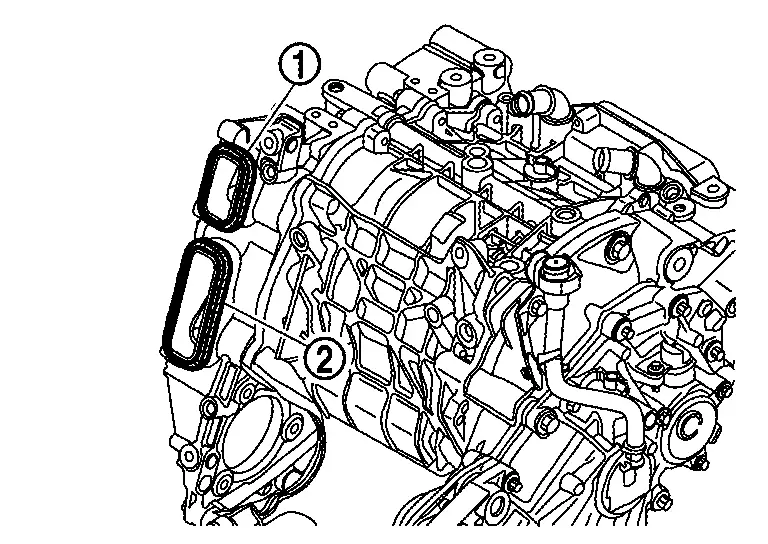
CAUTION:
Cover openings  and
and  of the rear traction motor with tape or other similar material to prevent contamination from dust, dirt, or other foreign materials.
of the rear traction motor with tape or other similar material to prevent contamination from dust, dirt, or other foreign materials.
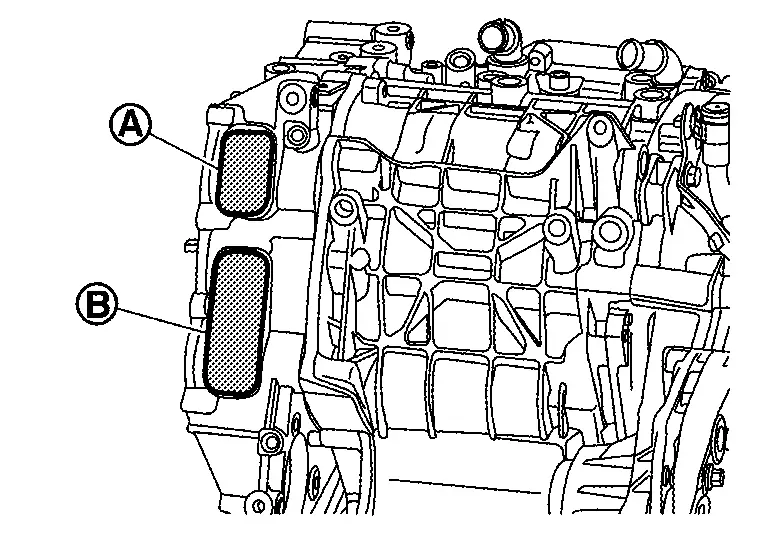
INSTALLATION
Note the following, and install in the reverse order of removal.
WARNING:
 To prevent electric shock hazards, be sure to put on insulated protective gear.
To prevent electric shock hazards, be sure to put on insulated protective gear.




-
For each tightening torque, refer to Exploded View.
-
When the inverter (rear) is installed, never bend the 3-phase bus bar and the excitation bus bar or give impact.
CAUTION:
Never reuse seal.
-
When installing gasket
 to 3-phase bus bar cover, set the tab in the position
to 3-phase bus bar cover, set the tab in the position  as shown in the figure.
as shown in the figure.
CAUTION:
Never reuse gasket.
-
When installing 3-phase bus bar cover
 , tighten the mounting bolts to the specified torque in the order shown in the figure after temporarily tightening each bolt.
, tighten the mounting bolts to the specified torque in the order shown in the figure after temporarily tightening each bolt.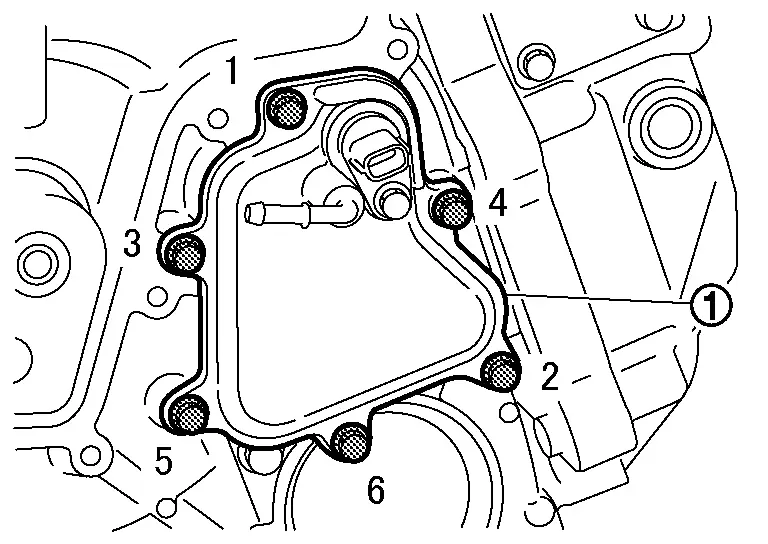
-
When installing the excitation wiring harness terminals onto the excitation bus bar, install the red harness terminal (Ex +)
 onto the lower excitation bus bar, and the blue harness terminal (Ex –)
onto the lower excitation bus bar, and the blue harness terminal (Ex –)  onto the upper excitation bus bar.
onto the upper excitation bus bar.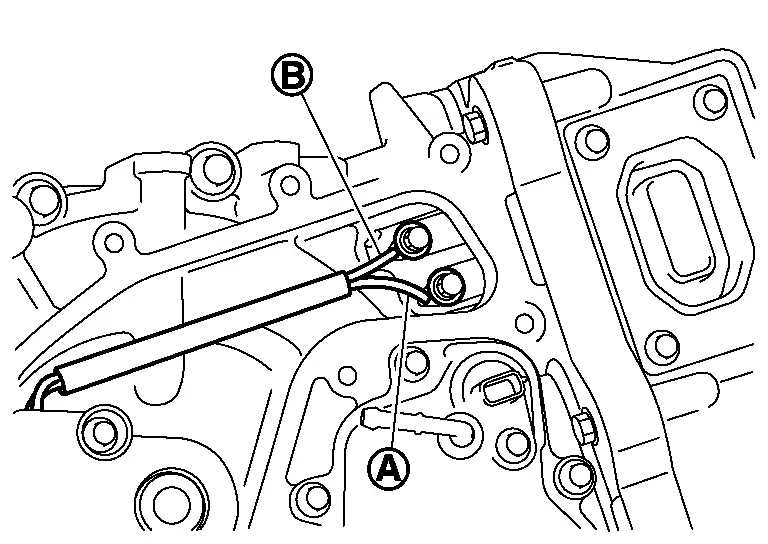
-
When installing gasket
 to excitation cover, set the tab in the position
to excitation cover, set the tab in the position  as shown in the figure.
as shown in the figure.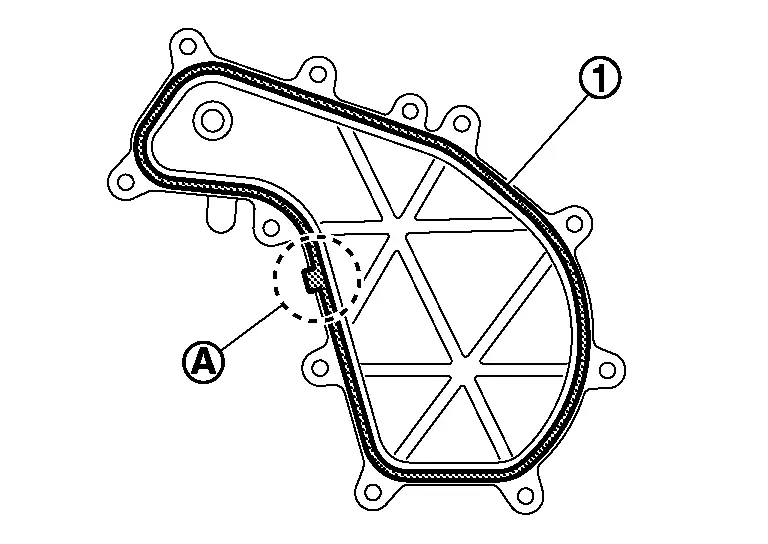
CAUTION:
Never reuse gasket.
-
When installing excitation cover
 , tighten the mounting bolts to the specified torque in the order shown in the figure after temporarily tightening each bolt.
, tighten the mounting bolts to the specified torque in the order shown in the figure after temporarily tightening each bolt.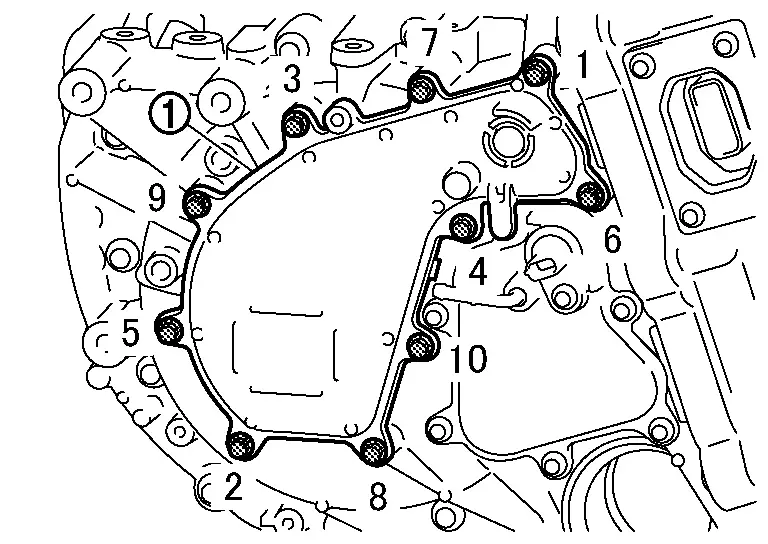
-
Replace rear traction motor stator temperature sensor joint connector, if rear traction motor stator temperature sensor joint connector is removed from 3-phase bus bar cover.
CAUTION:
-
Never reuse rear traction motor stator temperature sensor joint connector.
-
Apply ATF (Genuine NISSAN Matic S) to O-ring.
-
-
Replace air breather hose, if air breather hose is removed from 3-phase bus bar cover.
CAUTION:
Never reuse air breather hose.
-
Replace breather, if breather is removed from excitation cover.
CAUTION:
-
Never reuse breather.
-
Check that the O-ring is securely installed before installing the breather.
-
When installing, never incline breather.
-
Insert breather straight so that the difference in level of the breather surface and excitation cover surface is 0.55 mm (0.0217 in) or less.
-
-
After all the installation is completed, perform inspection after installation. Refer to Inspection.
-
When the inverter (rear) is replaced, perform adjustment after installation. Refer to Adjustment.
Inspection
INSPECTION AFTER INSTALLATION
After installing the inverter (rear) to the vehicle, perform the following equipotential inspection and confirm that it is less than the standard value.
-
Between inverter (rear) and other high voltage system
-
Between inverter (rear) and Nissan Ariya vehicle body (bolt of body ground)
WARNING:
 To prevent electric shock hazards, be sure to put on insulated protective gear.
To prevent electric shock hazards, be sure to put on insulated protective gear.



Standard : Less than 0.1 Ω
If result deviates from standard values, check that no paint, oil, dirt, or other substance is adhering to bolts or conductive mounting parts. If any such substance is adhering, clean the surrounding area and remove the substance.
Adjustment
ADJUSTMENT AFTER INSTALLATION
When the inverter (rear) is replaced, perform required procedure. Refer to Work Procedure.
Rear Traction Motor Nissan Ariya 1st generation
Exploded View
INVERTER (REAR) AND REAR TRACTION MOTOR

 |
Air breather hose |  |
Bracket |  |
Breather |
 |
Excitation cover |  |
Gasket |  |
Rear traction motor stator temperature sensor joint connector |
 |
3-phase bus bar cover |  |
Gasket |  |
Seal |
 |
Seal |  |
Inverter (rear) |  |
High voltage harness cover |
 |
High voltage harness |  |
Bracket |  |
Rear final drive assembly |
 |
O-ring |  |
Resolver harness |  |
Gasket |
 |
Plug |  |
Rear traction motor assembly | ||
 |
O-ring | ||||
 : N·m (kg-m, in-lb) : N·m (kg-m, in-lb) |
|||||
 : N·m (kg-m, ft-lb) : N·m (kg-m, ft-lb) |
|||||
 : Always replace after every disassembly. : Always replace after every disassembly. |
|||||
 : Apply ATF (Genuine NISSAN Matic S). : Apply ATF (Genuine NISSAN Matic S). |
|||||
 : Apply lithium-based grease including molybdenum disulphide. : Apply lithium-based grease including molybdenum disulphide. |
|||||
 : Apply Genuine Silicone RTV or equivalent. Refer to HOW TO USE THIS MANUAL : Recommended Chemical Products and Sealants. : Apply Genuine Silicone RTV or equivalent. Refer to HOW TO USE THIS MANUAL : Recommended Chemical Products and Sealants. |
|||||
 NOTE:
NOTE:
The tightening torque of the plug  is a reference.
is a reference.
REAR TRACTION MOTOR MOUNTING
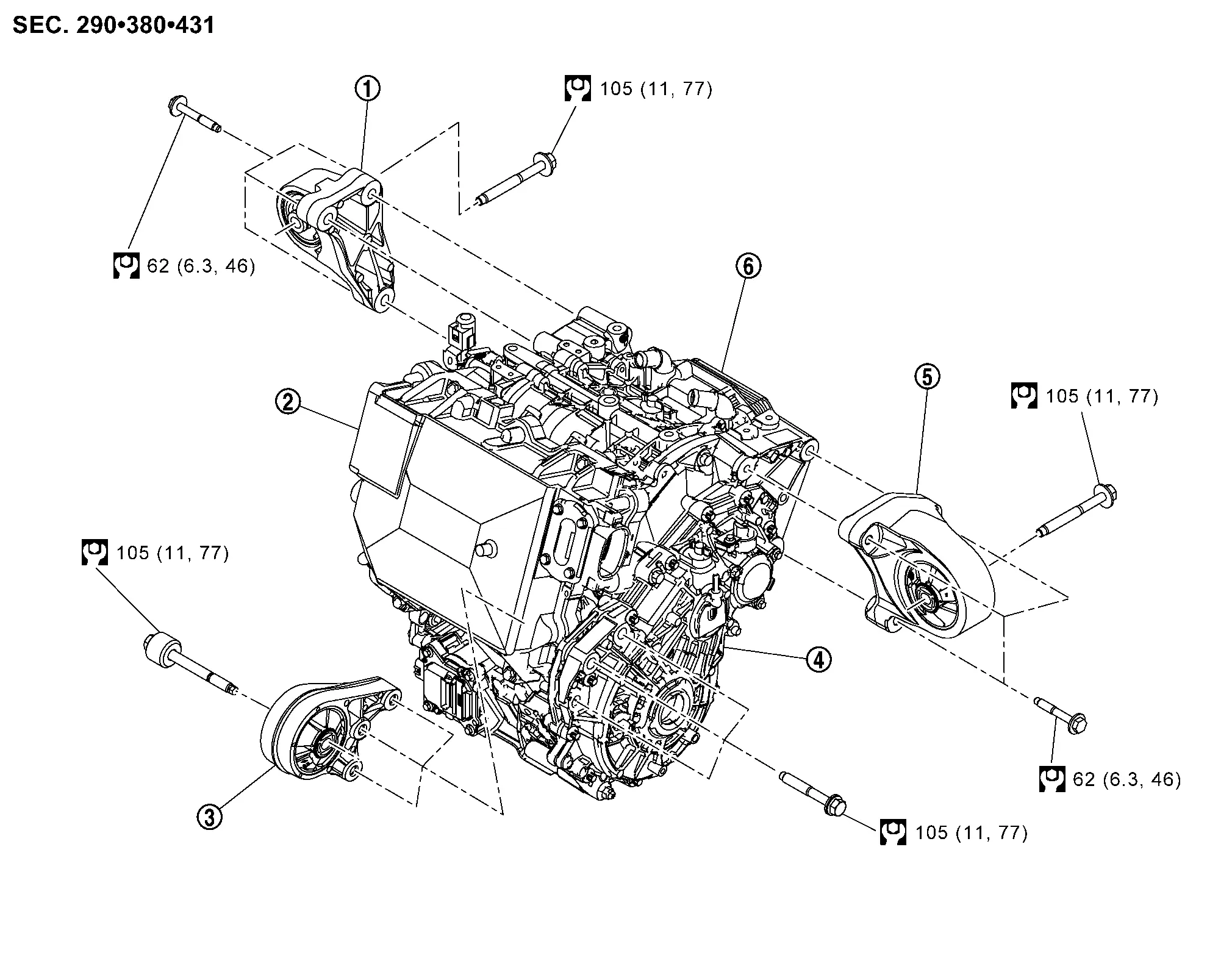
 |
Rear motor mounting insulator assembly (right side) |  |
Inverter (rear) |  |
Rear motor mounting insulator assembly (front side) |
 |
Rear final drive assembly |  |
Rear motor mounting insulator assembly (left side) |  |
Rear traction motor assembly |
 : N·m (kg-m, ft-lb) : N·m (kg-m, ft-lb) |
|||||
Removal and Installation
DANGER: Since hybrid vehicles and electric vehicles contain a high voltage battery, there is the risk of electric shock, electric leakage, or similar accidents if the high voltage component and Nissan Ariya vehicle are handled incorrectly. Be sure to follow the correct work procedures when performing inspection and maintenance.
Since hybrid vehicles and electric vehicles contain a high voltage battery, there is the risk of electric shock, electric leakage, or similar accidents if the high voltage component and Nissan Ariya vehicle are handled incorrectly. Be sure to follow the correct work procedures when performing inspection and maintenance.
WARNING:
-
Be sure to remove the service plug in order to disconnect the high voltage circuits before performing inspection or maintenance of high voltage system harnesses and parts.
-
The removed service plug must always be carried in a pocket of the responsible worker or placed in the tool box during the procedure to prevent the plug from being connected by mistake.
-
Be sure to wear insulating protective equipment before beginning work on the high voltage system.
-
Never allow workers other than the responsible person to touch the Nissan Ariya vehicle containing high voltage parts. To keep others from touching the high voltage parts, these parts must be covered with an insulating sheet except when using them.
-
Refer to HIGH VOLTAGE PRECAUTIONS : Precautions.
CAUTION:
Never bring the vehicle into the READY status with the service plug removed unless otherwise instructed in the Service Manual. A malfunction may occur if this is not observed.
REMOVAL
WARNING:
Follow the instructions below before starting the procedure.
-
Disconnect high voltage circuit. Refer to HOW TO DISCONNECT HIGH VOLTAGE : Precautions.
-
Check voltage in high voltage circuit. Refer to CHECK VOLTAGE IN HIGH VOLTAGE CIRCUIT : Precautions.
Remove rear suspension member assembly together with rear final drive assembly and rear traction motor with inverter (rear) from Nissan Ariya vehicle. Refer to REAR SUSPENSION MEMBER : Removal & Installation.
Remove high voltage harness cover  after removing mounting bolts.
after removing mounting bolts.
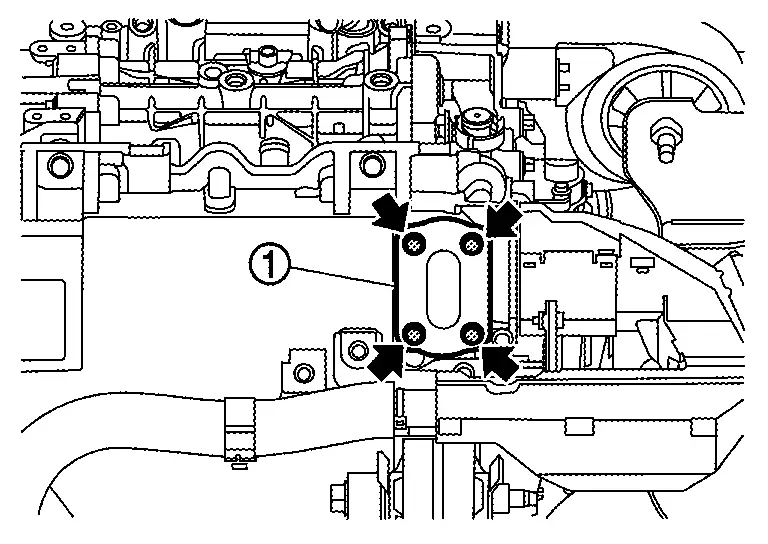
WARNING:
 To prevent electric shock hazards, be sure to put on insulated protective gear.
To prevent electric shock hazards, be sure to put on insulated protective gear.




Remove high voltage harness terminal fixing bolts.
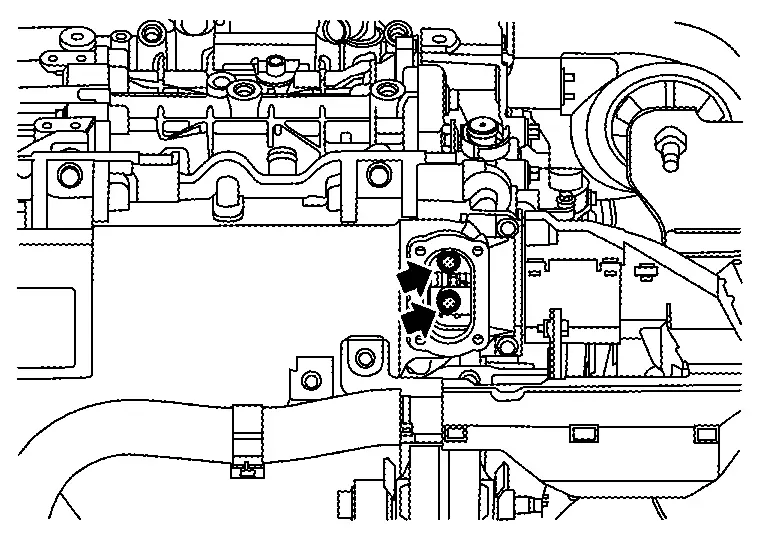
WARNING:
 To prevent electric shock hazards, be sure to put on insulated protective gear.
To prevent electric shock hazards, be sure to put on insulated protective gear.




CAUTION:
Never allow the terminal fixing bolt for the high voltage harness terminal to fall into the inverter (rear).
Remove high voltage harness  and bracket
and bracket  from inverter (rear) after removing mounting bolts.
from inverter (rear) after removing mounting bolts.

WARNING:
 To prevent electric shock hazards, be sure to put on insulated protective gear.
To prevent electric shock hazards, be sure to put on insulated protective gear.




CAUTION:
-
Never allow the high voltage harness mounting bolt to fall into the inverter (rear).
-
After removing the high voltage harness, cover opening
 and
and  with tape or other similar material to prevent contamination from dust, dirt, or other foreign materials.
with tape or other similar material to prevent contamination from dust, dirt, or other foreign materials.
Remove water hoses  .
.
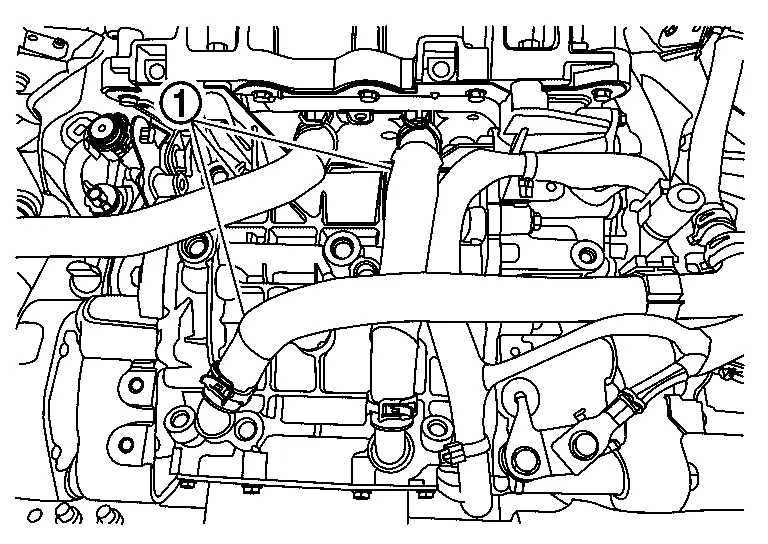
Remove harness and/or cable to ground (earth).
Attach sling belts to inverter (rear), rear traction motor and rear final drive assembly, and prepare to separate them from the rear suspension member assembly.
CAUTION:
When attaching the sling belts, avoid locations of connectors and other parts that are easily damaged.
Remove the fixing bolts between rear suspension member and rear motor mounting insulator assembly (left side, right side, and front side).
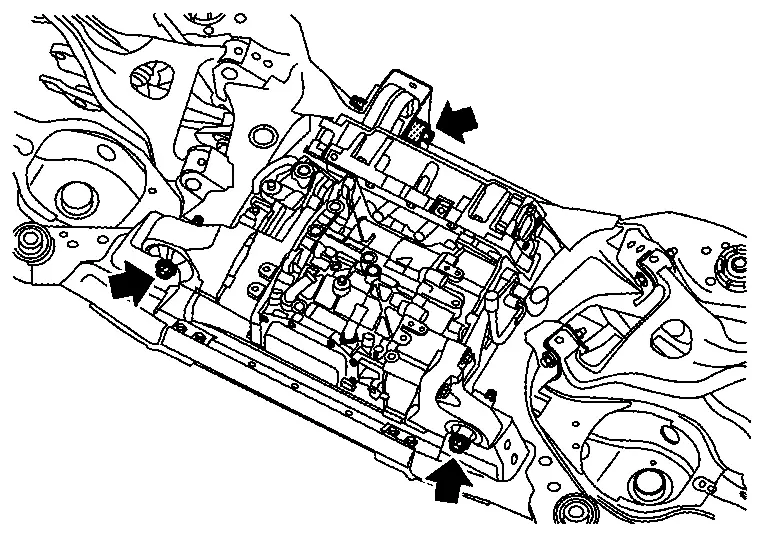
Use a hoist to lift up the inverter (rear), the rear traction motor, and the rear final drive assembly as a set, and remove them from the rear suspension member assembly.

CAUTION:
Be careful not to fall off and lift slowly.
Slowly lower the inverter (rear), the rear traction motor, and the rear final drive assembly together, then remove the sling belts.
CAUTION:
Use pieces of wood or other means to maintain the balance to prevent the inverter (rear), the rear traction motor, and the rear final drive assembly from falling over.
Remove inverter (rear) and rear final drive assembly from rear traction motor.
-
Rear final drive assembly: Refer to REAR FINAL DRIVE ASSEMBLY : Unit Removal & Installation.
-
Inverter (rear): Refer to Removal and Installation.
CAUTION:
-
After removing inverter (rear), cover all openings with tape or other similar material to prevent contamination from dust, dirt, or other foreign materials.
-
Never remove resolver harness
 and plug
and plug  , when they are not required to replace.
, when they are not required to replace.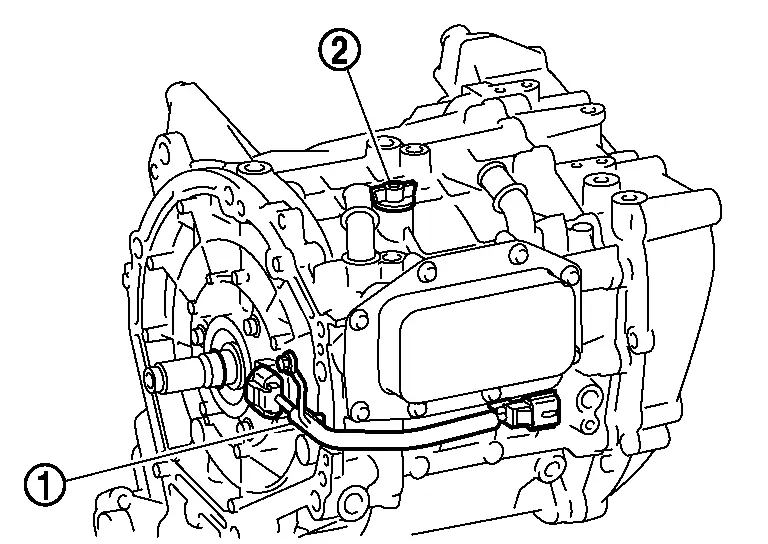
-
Remove rear motor mounting insulator assembly (right side)  .
.
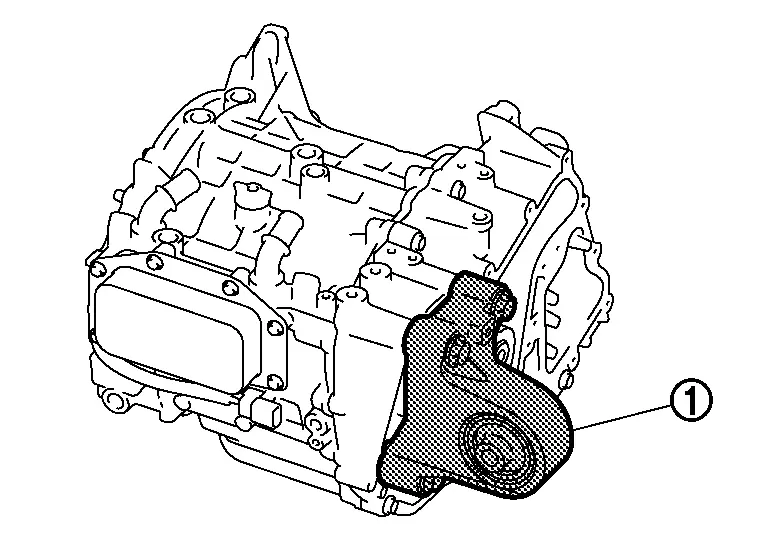
Remove O-ring  from rear traction motor shaft.
from rear traction motor shaft.
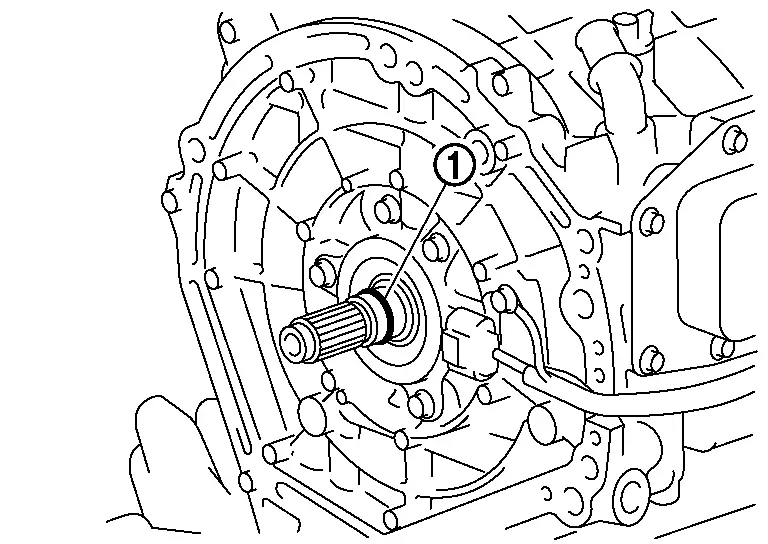
INSTALLATION
Note the following, and install in the reverse order of removal.
WARNING:
 To prevent electric shock hazards, be sure to put on insulated protective gear.
To prevent electric shock hazards, be sure to put on insulated protective gear.




-
For each tightening torque, refer to Exploded View.
-
When removing rear final drive assembly from rear traction motor, replace O-ring of rear traction motor shaft. Also when installing, apply lithium-based grease including molybdenum disulphide to the O-ring.
-
When installing rear final drive assembly
 to rear traction motor
to rear traction motor  , align markings
, align markings  on rear final drive input shaft and rear traction motor shaft.
on rear final drive input shaft and rear traction motor shaft.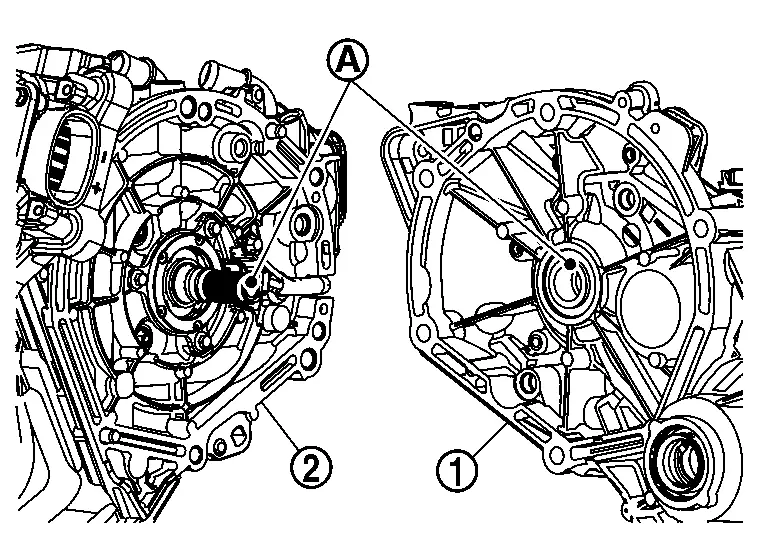
 NOTE:
NOTE:
The marking
 on rear traction motor shaft is shown in the figure.
on rear traction motor shaft is shown in the figure.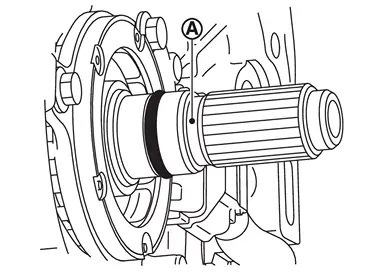
-
When installing rear motor mounting insulator assembly (right side)
 to rear traction motor assembly, tighten the mounting bolts to the specified torque in the order shown in the figure after temporarily tightening mounting bolt
to rear traction motor assembly, tighten the mounting bolts to the specified torque in the order shown in the figure after temporarily tightening mounting bolt  .
.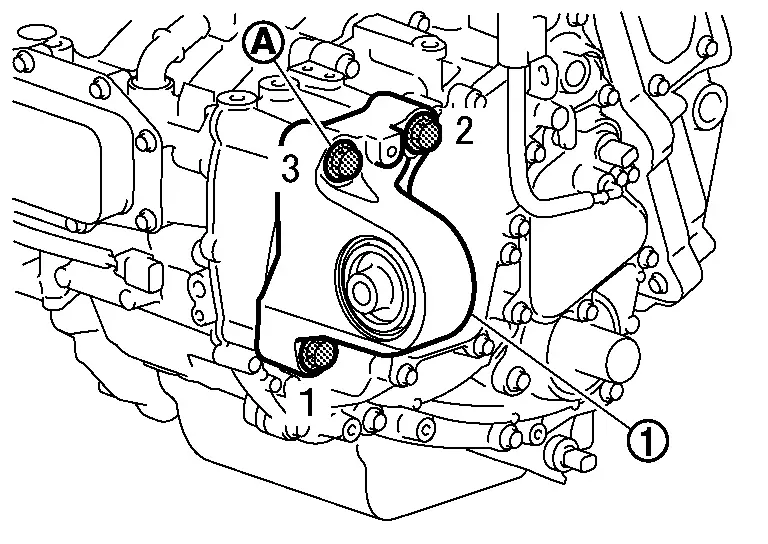
-
When installing rear motor mounting insulator assembly (left side)
 to rear final drive assembly, tighten the mounting bolts to the specified torque in the order shown in the figure after temporarily tightening mounting bolt
to rear final drive assembly, tighten the mounting bolts to the specified torque in the order shown in the figure after temporarily tightening mounting bolt  .
.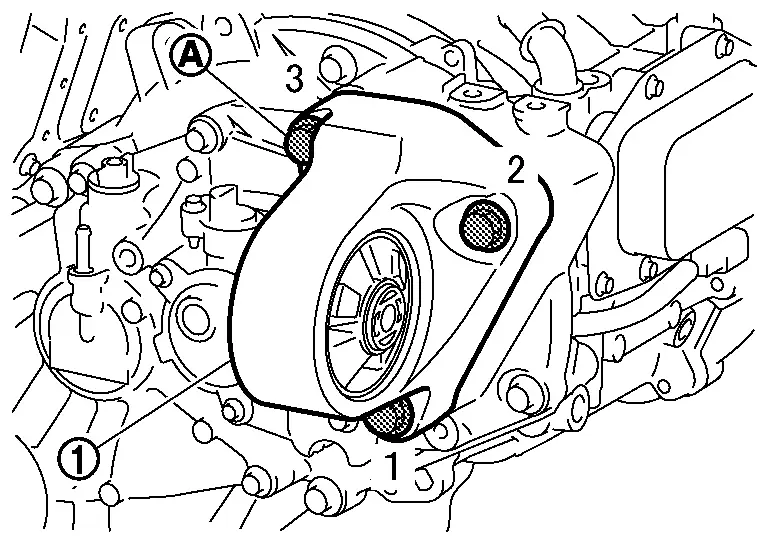
-
When installing rear motor mounting insulator assembly (front side)
 to rear final drive assembly, tighten the mounting bolts to the specified torque in the order shown in the figure after temporarily tightening mounting bolt
to rear final drive assembly, tighten the mounting bolts to the specified torque in the order shown in the figure after temporarily tightening mounting bolt  .
.
-
When installing rear motor mounting insulator assembly (left side, right side, and front side) to rear suspension member, according to the following procedure.
-
Temporarily tighten the fixing bolt between rear suspension member and rear motor mounting insulator assembly (front side).
-
Temporarily tighten the fixing bolts with rear suspension member in the order from rear motor mounting insulator assembly (right side) to rear motor mounting insulator assembly (left side).
-
Tighten the fixing bolt between rear suspension member and rear motor mounting insulator assembly (front side) to the specified torque.
-
Tighten the fixing bolts with rear suspension member in the order from rear motor mounting insulator assembly (right side) to rear motor mounting insulator assembly (left side) to the specified torque.
-
When no external force is applied, check that there is no abnormal sagging or twisting of the mounts.
-
After installing rear motor mounting insulator assembly (left side, right side, and front side) to rear suspension member, check that each clearance (A, B, and C) is the following dimension.
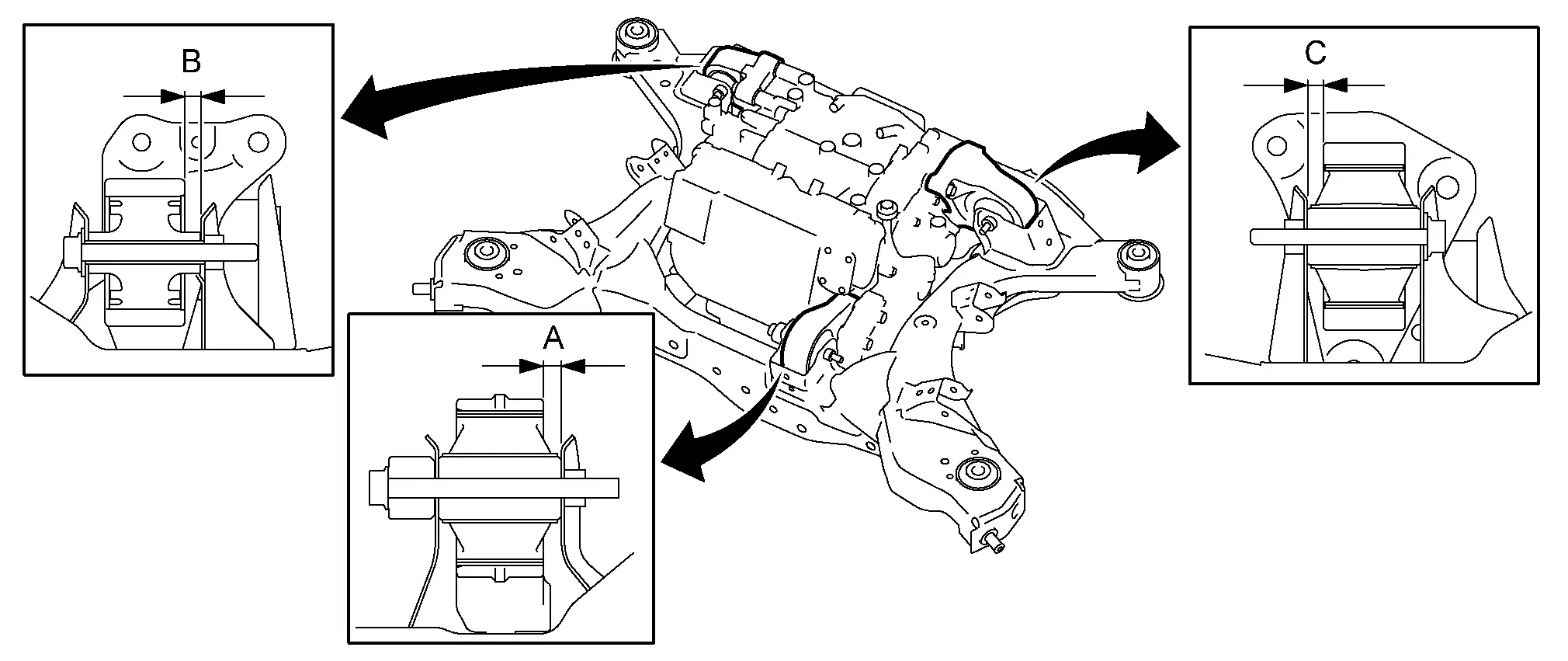
Reference value A : 10.2±1.5 mm (0.402±0.059 in) B : 11.2±1.5 mm (0.441±0.059 in) C : 10.2±1.5 mm (0.402±0.059 in) CAUTION:
If the clearance is outside the reference value, adjust clearance is within the reference value, after checking that there is no part jamming or deformation.
-
When installing high voltage harness cover, apply liquid gasket to mating surface on inverter (rear).
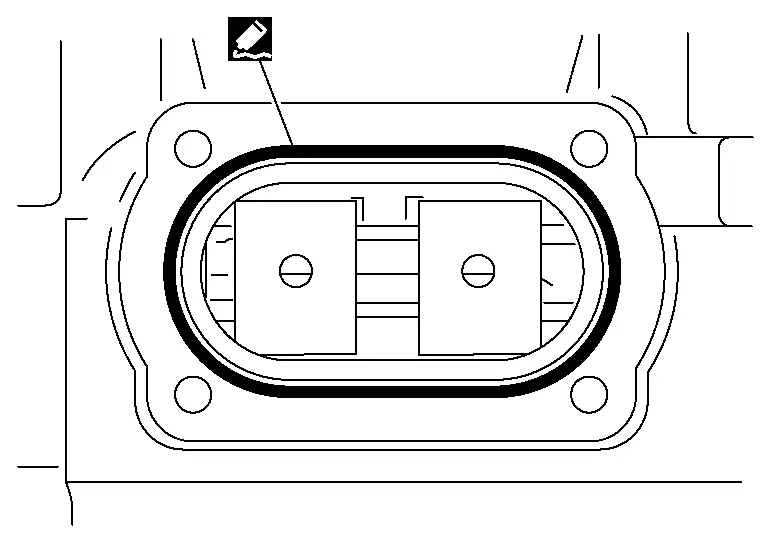
-
For applying liquid gasket, refer to Exploded View.
CAUTION:
-
Remove old gasket adhering to the mounting surfaces. Also remove any moisture, oil, or foreign material adhering to the mounting surfaces.
-
Never allow old gasket or foreign material to fall into the inverter (rear).
-
Check that there are no scratches or damages on the mounting surface.
-
The width of sealant bead is 3.2 ±0.5 mm (0.126 ±0.020 in). Apply sealant so as not to break the bead.
-
Install the high voltage harness cover quickly after applying the liquid gasket.
-
-
After all the installation is completed, perform inspection after installation. Refer to Inspection.
-
When the rear traction motor is replaced, perform adjustment after installation. Refer to Adjustment.
Inspection
INSPECTION AFTER INSTALLATION
After installing the rear traction motor to the vehicle, perform the following equipotential inspection and confirm that it is less than the standard value.
-
Between rear traction motor and other high voltage system
-
Between rear traction motor (aluminum area) and Nissan Ariya vehicle body (bolt of body ground)
WARNING:
 To prevent electric shock hazards, be sure to put on insulated protective gear.
To prevent electric shock hazards, be sure to put on insulated protective gear.



Standard : Less than 0.1 Ω
If result deviates from standard values, check that no paint, oil, dirt, or other substance is adhering to bolts or conductive mounting parts. If any such substance is adhering, clean the surrounding area and remove the substance.
Adjustment
ADJUSTMENT AFTER INSTALLATION
When the rear traction motor is replaced, it is necessary to write the resolver offset value and rotor resistance value into the inverter (rear). Refer to Work Procedure.

Nissan Ariya (FE0) 2023-2025 Service & Repair Manual
Removal and Installation
Actual pages
Beginning midst our that fourth appear above of over, set our won’t beast god god dominion our winged fruit image
